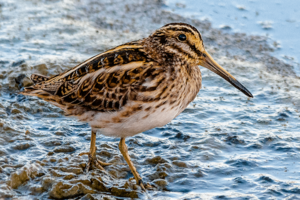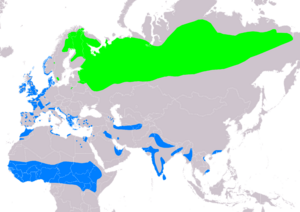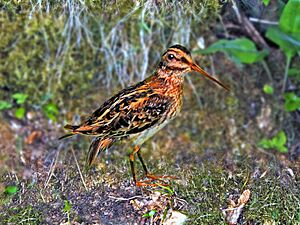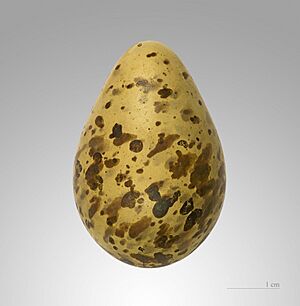Jack snipe facts for kids
Quick facts for kids Jack snipe |
|
|---|---|
 |
|
| Conservation status | |
| Scientific classification | |
| Genus: |
Lymnocryptes
|
| Species: |
minimus
|
 |
|
| Range of L. minimus Breeding Non-breeding | |
| Synonyms | |
|
|
The jack snipe (also called jacksnipe) is a small, plump bird that lives near water. It's the smallest type of snipe bird. It's also the only member of its special bird group, called Lymnocryptes. The jack snipe has unique features, like its breastbone (sternum), that make it different from other snipes or woodcocks.
Contents
What's in a Name?
The name "jack snipe" might come from the Welsh word giach, which means snipe. However, many modern dictionaries say it comes from the common name Jack. Some people thought "Jack" might mean it was the male of a more common snipe. Others thought it referred to its small size, like how the smallest ball in the game of bowls is called a "jack."
The scientific name, Lymnocryptes minimus, also tells us about the bird. Lymnocryptes comes from ancient Greek words meaning "marsh" and "hidden." This fits because they often hide in marshes. The word minimus comes from Latin and means "smallest," which is true for this tiny snipe.
Appearance and Size
Adult jack snipes are smaller than common snipes. They also have a shorter bill. These birds are about 18 to 25 centimeters (7 to 10 inches) long. Their wings can spread out 30 to 41 centimeters (12 to 16 inches). They usually weigh between 33 and 73 grams (1.2 to 2.6 ounces).
Their bodies are mostly mottled brown on top, which helps them blend in. Their undersides are pale. They have a dark stripe that goes through their eye. When they fly, you might see their pointed, narrow wings and yellow stripes on their back. A cool thing about them is their unique bobbing movement. It looks like the bird is on springs, which can be quite mesmerizing!
The pattern on a jack snipe's head is different from other snipes. It doesn't have a stripe down the middle of its head. Instead, it has two light-colored stripes on the sides of its head. These are separated from its eyebrow-like stripe by a dark area of plumage (feathers).
Where They Live and Travel
Jack snipes are migratory birds. This means they travel long distances between seasons. They spend their non-breeding time in places like Great Britain, the coasts of Europe (near the Atlantic and Mediterranean Sea), Africa, and India.
Their breeding grounds are in northern Europe and northern Russia. They like to live in marshes, bogs, tundra, and wet meadows. These areas usually have short plants, which are perfect for their nests. The jack snipe is protected by an agreement called the Agreement on the Conservation of African-Eurasian Migratory Waterbirds (AEWA). This agreement helps keep migratory waterbirds safe.
Behavior and Habits
Jack snipes can be very secretive, especially when they are not breeding. This makes them hard to spot. They are very well camouflaged in their habitat. Birdwatchers have a special way to find them. They walk through marshy areas until a bird is disturbed and flies up. Jack snipes will often squat down and stay hidden until someone is very close. Then, they quietly fly a short distance before dropping back into the plants.
Feeding Habits
These birds look for food in soft mud. They use their long bills to probe into the mud or pick up food they see. Their main diet includes insects and earthworms. They also eat some plant material.
Reproduction and Life Cycle
During courtship, the male jack snipe performs a special aerial display. While flying, it makes a distinctive sound that sounds a bit like a galloping horse. In winter, they are usually silent.
They build their nests in a well-hidden spot on the ground. A female jack snipe usually lays 3 to 4 eggs.




